Chairs. Part 5
Description
This section is from the book "Furniture Of The Olden Time", by Frances Clary Morse. Also available from Amazon: Furniture of the Olden Time.
Chairs. Part 5
Illustration 158 shows an easy-chair with the Dutch bandy leg and foot, owned by the writer. Such chairs were inventoried very high, from one pound to ten, and when one considers the amount of material required to stuff and cover the chair, the reason for the high valuation is understood. In the days when the fireplace gave what heat there was in the room, these great chairs must have been most comfortable, with the high back and sides to keep out draughts.
An easy-chair with claw-and-ball feet is shown in Illustration 159. It is owned by Francis H. Bigelow, Esq., of Cambridge. A beautiful easy-chair with carved cabriole legs, owned by Harry Harkness Flagler, Esq., is shown in Illustration 248.
We now come to the most important period in the consideration of chairs, - the last half of the eighteenth century. During this period many books of designs were published, which probably came to this country within a year or two of their publication, and which afforded American cabinet-makers an opportunity for copying the best English examples.
Chippendale's designs were published in 1753, Hepplewhite's in 1789, Sheraton's in 1791. Besides these three chief chair-makers, there were Ince and Mayhew, 1765; Robert Manwaring, 1765; R. and J. Adam, 1773; and others of less note.
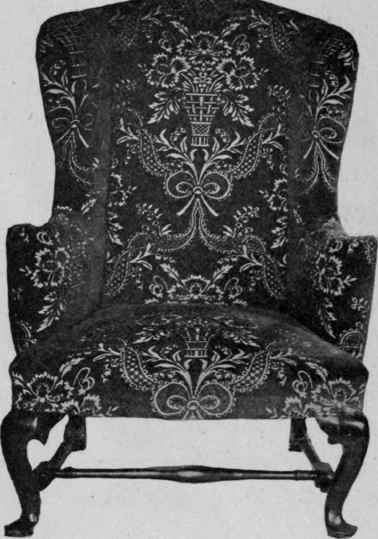
Illus. 158. - Easy-Chair with Dutch Legs, 1750.
Chippendale drew most of his ideas from the French, notably in the way of ornamentation, but the form of his chairs was developed chiefly from the Dutch style, with the bandy leg and splat in the back. His straight-legged chairs were suggested by the Chinese furniture, which was fashionable about the middle of the eighteenth century. These various styles Chippendale adapted, and employed with such success that his was the strongest influence of the century upon furniture, and for a period of over thirty years it was supreme.
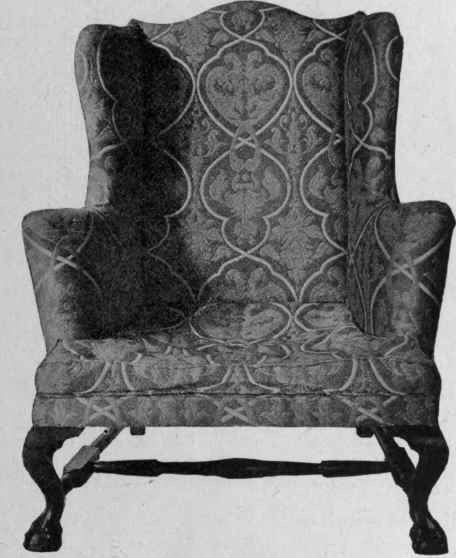
Illus. 159. - Claw-and-ball-foot Easy-chair, 1750.
The claw-and-ball foot does not appear upon any of Chippendale's designs in "The Gentleman's and Cabinet-Maker's Director." His preference was plainly for the French scroll foot, shown upon the sofa in Illustration 209 and the candle-stand in Illustration 333. Doubtless, however, he made furniture with the claw-and-ball foot, which was the foot used by the majority of his imitators and followers.
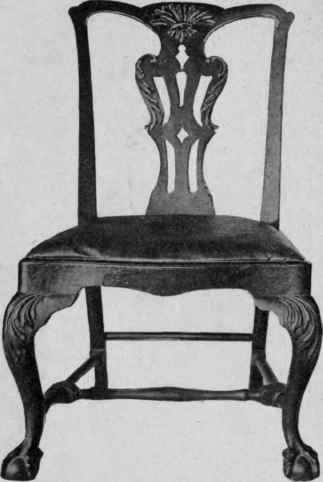
Illus. 160. - Chippendale Chair.
An early Chippendale chair is shown in Illustration 160, from the Poore collection at Indian Hill, with stretchers, which are unusual in a Chippendale chair. The cabriole legs are carved upon the knee and end in a claw-and-ball foot. The top of the back has the bow form, which is a distinguishing characteristic of Chippendale. This chair-seat and the one following are very large and broad.

Illus. 161. - Chippendale Chair.
The lines in the back of the chair in Illustration 161 form a series of curves, extremely graceful in effect, and the carving upon the back and legs is very fine. This chair is one of a set of six owned by Harry Harkness Flagler, Esq.
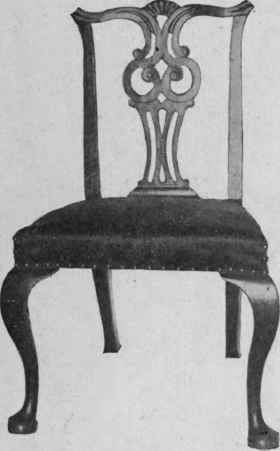
Illus. 163. - Chippendale Chair.
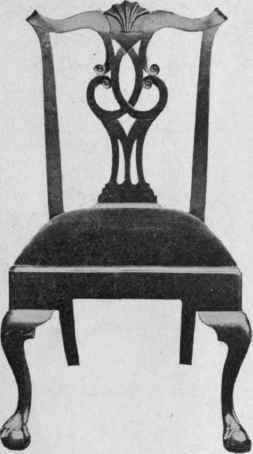
Illus. 162. - Chippendale Chair.
Illustration 162 shows a chair owned by Miss Mary Coates of Philadelphia. The design of the back, with some variations, is often seen. The top forms a complete bow with the ends turning up, and a shell is carved in the centre.

Illus. 165. - Chippendale Chairs.
A variation of this back is shown in Illustration 163. The top has a fan instead of a shell, and the ends of the bow top are grooved. This chair is one of a set formerly owned by Miss Rebecca Shaw of Wickford, Rhode Island, who died in 1900, over ninety years of age. They are now in the possession of Mrs. Alice Morse Earle of Brooklyn, New York. A fine arm-chair owned by Miss Mary Coates is shown in Illustration 164.
Two very beautiful and unusual Chippendale arm-chairs are shown in Illustration 165. They are owned by Harry Harkness Flagler, Esq., and the larger chair, which was formerly in the Pendleton collection, is undoubtedly an original Chippendale. Its proportions are perfect, and the elaborate carving is finely done. The other chair presents some Dutch characteristics, in the shape of the seat and back, but the details of the carving indicate it to be after the school of Chippendale.
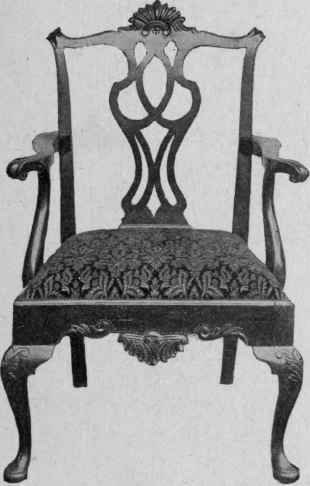
Illus. 164. - Chippendale Chair.
Illustration 166 shows a graceful chair with carving upon the back and knees. It belonged formerly to Governor Strong of Massachusetts, and is now owned by W. S. G. Kennedy, Esq., of Worcester.

IIlus. 167. - Roundabout Chair.

Illus. 166. - Chippendale Chair.
The roundabout chair in Illustration 167 was originally owned by the Rev. Daniel Bliss, the Congregational minister in Concord, Massachusetts, from 1739 to 1766. He was succeeded by William Emerson, who married his daughter, and who was the grandfather of Ralph Waldo Emerson.
William Emerson died in 1777, and Dr. Ezra Ripley succeeded to the pastorate and the widow, and took possession of the manse and of this chair, which must have served the successive ministers at the desk, while many hundreds of sound sermons were written. It now belongs to the Concord Antiquarian Society.
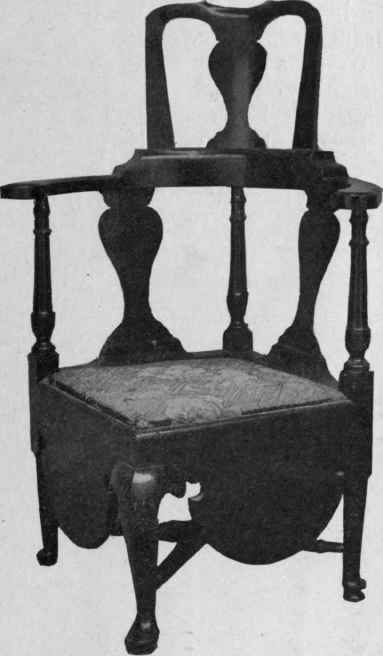
Illus. 168. - Extension-top Roundabout Chair.
An unusually fine example of a Dutch corner chair with an extension top, is shown in Illustration 168, owned by the Metropolitan Museum of Art.
Continue to:


